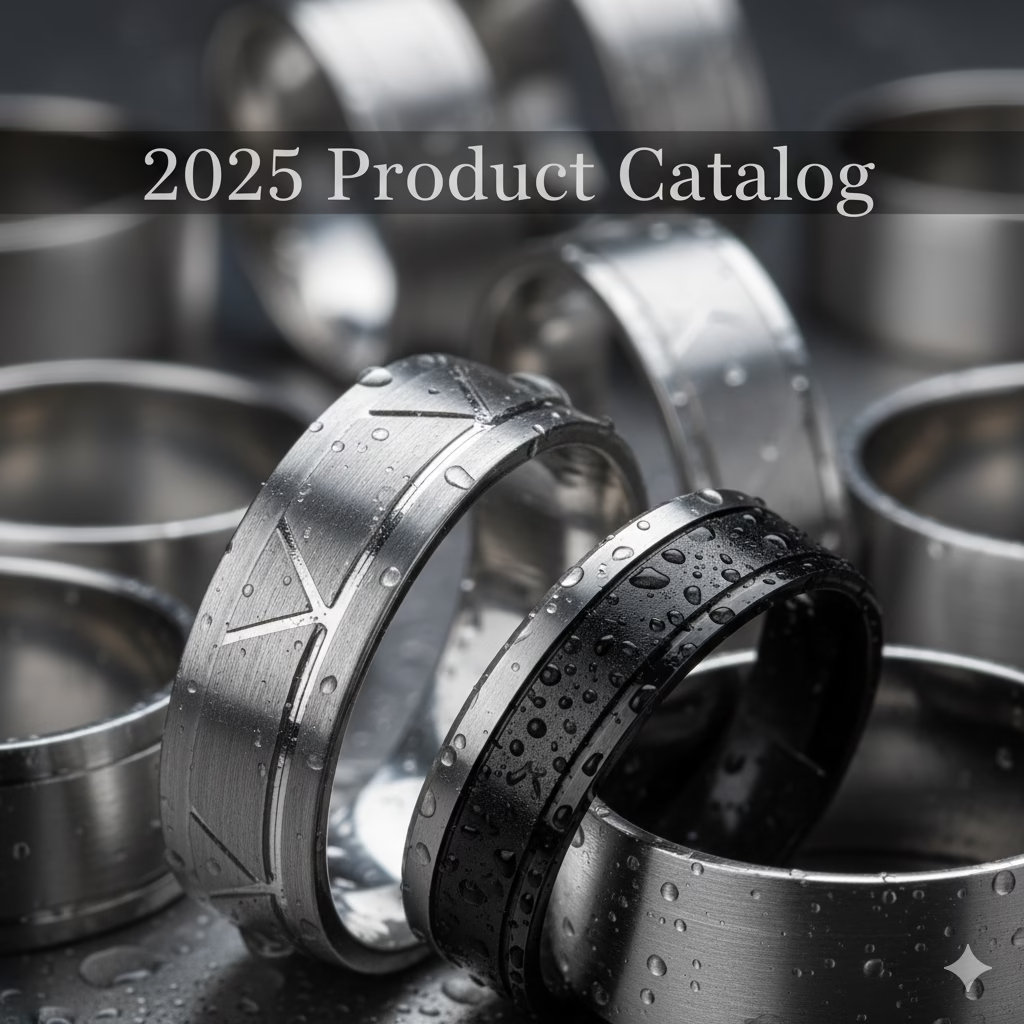Stainless steel is an alloy mainly composed of iron, carbon, and at least 10.5% chromium. The chromium forms a thin, invisible layer on the surface, preventing rust and corrosion. Other elements such as nickel, molybdenum, and manganese may be added to enhance strength, shine, and durability.
Key Properties of Stainless Steel
- Durability: Highly resistant to scratches and wear, making it ideal for daily use
- Corrosion Resistance: Does not easily rust or tarnish due to chromium content
- Hypoallergenic: Usually nickel-free or low in nickel, minimizing allergic reactions
- Affordable: Less expensive than precious metals like gold or platinum
Popularity in Rings and Jewelry
Stainless steel’s toughness combined with its sleek, modern look makes it a favorite for rings and everyday jewelry. It offers a long-lasting shine and withstands daily wear better than many metals.
| Metal | Durability | Tarnish Resistance | Hypoallergenic | Affordability |
|---|
| Stainless Steel | Very High | Excellent | Yes | Very Affordable |
| Silver | Moderate | Tarnishes Easily | Moderate | Moderate |
| Gold | Moderate-High | Rarely Tarnishes | Usually Yes | Expensive |
| Titanium | Very High | Excellent | Yes | Moderate |
Compared to silver and gold, stainless steel is more durable and affordable, while rivaling titanium’s resistance to tarnishing and wear. This balance makes it an excellent choice for anyone seeking stylish, low-maintenance rings.
Do Stainless Steel Rings Tarnish

Tarnishing means a metal’s surface changes color or loses its shine over time, usually due to a chemical reaction with air or moisture. In jewelry, this often shows as dullness or discoloration.
Stainless steel rings generally do not tarnish because they contain chromium, which forms a protective layer that keeps the metal shiny and stops it from reacting with oxygen or moisture. This makes stainless steel very popular for rings that stay looking good without much fuss.
However, under certain conditions, stainless steel might discolor or develop surface blemishes, such as:
- Exposure to harsh chemicals like chlorine or bleach
- Contact with saltwater or sweat, which can leave deposits
- Physical wear causing tiny scratches that trap dirt or oils
It’s important to know that tarnishing is different from corrosion or rusting. Tarnishing is a surface-level change that can be cleaned off, while rusting (a form of corrosion) happens when iron in the metal reacts with oxygen and water, causing deeper damage. Because stainless steel has little iron exposure on its surface, it rarely rusts if cared for properly.
| Tarnishing | Rusting (Corrosion) |
|---|
| Surface dullness or discoloration | Deep iron oxide damage |
| Usually reversible with cleaning | Often permanent and damaging |
| Caused by chemical reactions on surface | Caused by breakdown of metal itself |
| Common in silver and some other metals | Rare in high-quality stainless steel |
Factors That Might Affect Stainless Steel Ring Appearance

Even though stainless steel rings are tough and resistant to tarnish, some factors can impact how they look over time.
Exposure to Harsh Chemicals
Chlorine, bleach, and saltwater are rough on stainless steel. These chemicals can cause discoloration or surface damage if your ring comes into contact with them frequently—like swimming in pools or using strong cleaning products without taking off your ring.
Physical Wear and Tear
Scratches can happen with everyday use. Unlike tarnish, which is a surface discoloration, scratches affect the metal itself. Stainless steel is hard, but it’s not scratch-proof, so be mindful when doing heavy work or contact sports.
Exposure to Sweat, Lotions, Perfumes, and Oils
Oils from your skin, along with lotions and perfumes, can build up on the ring’s surface. While this doesn’t cause true tarnishing, it can dull the shine. Regular cleaning helps keep your ring looking fresh.
Low-Grade vs High-Grade Stainless Steel
How to Care for and Maintain Stainless Steel Rings
Keeping your stainless steel ring shiny and looking new is easy with the right care. Here are some simple tips to maintain your ring’s finish:
Cleaning Tips for Keeping the Shine
- Use warm water and mild soap to clean your ring regularly.
- Gently scrub with a soft toothbrush or cloth to remove dirt and oils.
- Rinse well and dry with a soft cloth to avoid water spots.
Best Cleaning Agents to Use and Avoid
- Use: Mild dish soap, baking soda paste, and specialized stainless steel jewelry cleaners.
- Avoid: Harsh chemicals like bleach, ammonia, or abrasive cleaners that can damage the surface.
Storage Advice to Prevent Surface Damage
- Store your ring in a soft pouch or a separate compartment to avoid scratches.
- Keep it away from humidity and direct sunlight to maintain its shine.
- Avoid placing it near other jewelry that may cause nicks or abrasion.
When to Seek Professional Cleaning and Maintenance
- If your ring has tough stains, deep scratches, or discoloration that regular cleaning can’t fix, consider a professional polish.
- Jewelry experts can safely restore your stainless steel ring without damaging it.
- Annual professional cleanings help keep your ring looking its best over time.
Common Myths About Stainless Steel Rings and Tarnishing
There are a few common myths floating around about stainless steel rings, especially when it comes to tarnishing and rusting. Let’s clear those up.
Myth 1: Stainless steel rings rust or tarnish easily.
In reality, stainless steel is highly resistant to rust and tarnish thanks to its chromium content, which forms a protective layer. While no metal is 100% immune to wear, stainless steel holds up much better than silver and sometimes even gold when it comes to maintaining its shine over time.
Myth 2: Stainless steel causes allergic reactions.
Many people assume stainless steel irritates skin, but most stainless steel rings are hypoallergenic. This means they’re safe even for sensitive skin and won’t cause common metal allergies linked to nickel or other metals found in cheaper jewelry.
Myth 3: Discoloration means the ring is low quality or fake.
Discoloration or slight surface blemishes often come from external factors like exposure to chemicals, sweat, or lotions rather than the metal itself. High-grade stainless steel rings rarely show discoloration if cared for properly.
Understanding these truths can help you feel confident choosing stainless steel rings—they combine style, durability, and low-maintenance wear without the worry of common misconceptions.
Why Choose Stainless Steel Rings from SteelRingFactory
At SteelRingFactory, quality is our top priority. We use only high-grade stainless steel to make rings that last. This means you get durable, tarnish-resistant rings that keep their shine even with everyday wear.
We focus on:
- Premium Materials: Our rings are made from surgical-grade stainless steel, ensuring strength and hypoallergenic comfort.
- Durability: Resistant to rust, scratches, and discoloration, perfect for daily use.
- Long-Lasting Shine: Our finishing process helps maintain the ring’s polished look over time.
What Our Customers Say
Many customers love how our rings stay bright and strong through daily activities. We back our products with quality guarantees to give you peace of mind.
| Feature | Benefit |
|---|
| High-Grade Steel | Hypoallergenic and strong |
| Tarnish Resistant | Maintains shine longer |
| Quality Guarantee | Confidence in your purchase |
Choosing SteelRingFactory means investing in a ring built for real life—durable, easy to maintain, and stylish for years to come.














